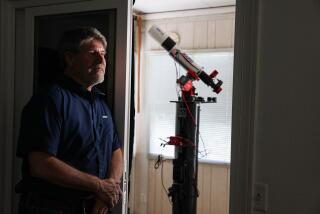Astronomers Solve Gamma Ray Mystery
In a collaborative effort, astronomers around the world have conclusively linked two of the grandest explosions in the cosmos -- gamma ray bursts and supernovae -- solving a mystery that has plagued astronomers for more than 30 years.
Since the initial detection of gamma rays in 1967, astronomers have been looking for the source of the brief explosions in a wavelength not visible to the naked eye that come without warning and release as much energy as a billion trillion suns.
For the record:
12:00 a.m. June 27, 2003 For The Record
Los Angeles Times Friday June 27, 2003 Home Edition Main News Part A Page 2 National Desk 1 inches; 41 words Type of Material: Correction
Gamma rays -- An article in Saturday’s Section A regarding gamma ray bursts and supernovae incorrectly noted that gamma rays were first detected in 1967. It should have stated that gamma ray bursts were first detected in outer space in 1967.
On March 29, a satellite collaboratively operated by the United States, Japan, France and Italy detected a strong gamma ray burst. The coordinates for the burst were communicated over the Internet to dozens of observatories around the world.
In 90 minutes, a telescope in Australia detected a bright light in the direction of the burst, and in less than a week an observatory in Chile analyzed the source of the light, allowing astronomers to determine that it was caused by the explosion of a star more than 25 times as heavy as Earth’s sun -- an event known as a hypernova.
“This is the event of the decade,” said Chryssa Kouveliotou, a senior scientist at Marshall Space Flight Center in Alabama and coauthor of an article published in the journal Nature.
Gamma ray bursts occur throughout the universe several times a day in galaxies billions of light-years from Earth.
If such a burst were to occur on the other side of our galaxy, “it would be as bright as the sun,” said coauthor Stan Woosley, professor of astrophysics at UC Santa Cruz. “But don’t worry, they don’t happen but every 10 million years in a given galaxy.”




